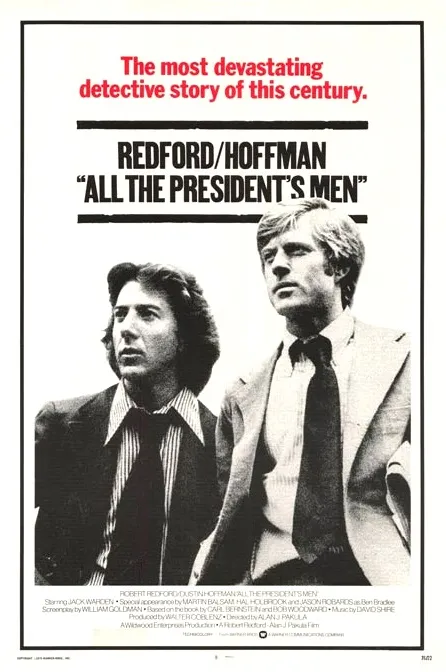
All the President's Men is a 1976 American biographical political drama thriller film about the Watergate scandal that led to the resignation of President Richard Nixon. Directed by Alan J. Pakula, the film is based on the book "All the President's Men" by William Goldman and produced by Walter Coblenz. The movie stars Robert Redford as Bob Woodward and Dustin Hoffman as Carl Bernstein, two reporters working for the Washington Post who uncover the details of the scandal.
The film is known for its meticulous production and the strong performances of Redford and Hoffman. It has a runtime of 138 minutes and a budget of $8.5 million, grossing $70.6 million at the box office. "All the President's Men" has received positive reviews for its portrayal of the benefits of a free press and the dangers of unchecked power.
Plot
All the President's Men is a 1976 American biographical political drama thriller film about the Watergate scandal that led to the resignation of President Richard Nixon. The movie follows the story of two reporters, Bob Woodward and Carl Bernstein, who work for the Washington Post and uncover the details of the scandal. The film portrays the benefits of a free press and the dangers of unchecked power. The movie stars Robert Redford as Bob Woodward and Dustin Hoffman as Carl Bernstein. The film has a runtime of 138 minutes and has received positive reviews for its meticulous production and strong performances.
Trailer
@taskmaster4450le/re-leothreads-36xig7pt7
Cast
- Dustin Hoffman as Carl Bernstein
- Robert Redford as Bob Woodward
- Jack Warden as Harry M. Rosenfeld
- Martin Balsam as Howard Simons
- Hal Holbrook as Deep Throat
- Jason Robards as Ben Bradlee
- Jane Alexander as Judy Hoback
- Meredith Baxter as Debbie Sloan
Director: Alan J. Pakula
Writer: Carl Bernstein, Bob Woodward, William Goldman
Box Office Gross: $70,600,414
Genre: Drama
Distributor: Warner Bros. Pictures
Release Date (Theaters): Jan 1, 1976
Release Date (Streaming): Feb 16, 2010
Theme
The theme of All the President's Men revolves around the importance of investigative journalism, the power of the press, and the dangers of unchecked power. The film showcases the role of Bob Woodward and Carl Bernstein as they uncover the truth behind the Watergate scandal, ultimately leading to the resignation of President Richard Nixon.
Reception
The film has received positive reviews for its portrayal of the benefits of a free press and the dangers of unchecked power. It has been praised for its meticulous production and strong performances, particularly those of Robert Redford and Dustin Hoffman.
Production Challenges
One of the main challenges faced during the production of All the President's Men was balancing the journalistic practice with the cinematic storytelling. The screenwriter, William Goldman, faced objections from some journalists regarding the liberties taken with the truth in the film.
Settings
The film is set primarily in Washington, D.C., where the Watergate scandal took place. Key locations include the Washington Post newsroom, the Library of Congress, and various other places related to the investigation.
Visual Styles
The visual style of the film is characterized by a blend of dramatic lighting, ominous musical score, and masterful camera angles. One notable scene is the Library of Congress sequence, where the camera starts on Redford and Hoffman as they go through stacks of book request slips, pulling farther up in the library's massive rotunda.
Techniques
The film employs various techniques to create a suspenseful and engaging atmosphere. For example, the scene in the Library of Congress features a slow zoom and a high angle shot, which adds tension to the scene. Additionally, the film uses voiceovers and flashbacks to convey the necessary information and context.
Trivia
- The film is based on the book All the President's Men by William Goldman, who also co-wrote the screenplay with Carl Bernstein.
- The movie was released on April 9, 1976, and earned more than $70 million at the box office.
- "All the President's Men" won four Oscars, including awards for art direction and set decoration, and sound.
Fun Facts
- The film's director, Alan J. Pakula, was known for his attention to detail and his ability to create a tense and engaging atmosphere.
- The film's editor, William H. Reynolds, played a significant role in shaping the film's pacing and rhythm.
- The film's cinematographer, Gordon Willis, was known for his innovative camera techniques and dramatic lighting.
General:
Page by @iskafan
